This website has been archived from TrainWeb.org/girr to TrainWeb.US/girr.
This website has been archived from TrainWeb.org/girr to TrainWeb.US/girr.
The Death Valley Railroad was incorporated January 1914 to build a line for the Tonopah and Tidewater Railroad at Death Valley Junction to New Ryan in Death Valley. The line was completed by December 1914 and operations started with two Baldwin 2-8-0 locomotives built in June, 1914.
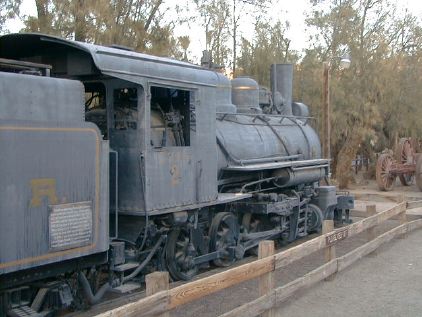 On display at the Borax Museum in Death Valley
National Park is a fairly well preserved small wheeled
Consolidation that had been used to haul ore. Since Death Valley
gets only about 2" of rain a year (and most of that in maybe one
thunderstorm), iron and steel artifacts don't rust away very fast
out here. Summertime humidity can get down to 0.5%
On display at the Borax Museum in Death Valley
National Park is a fairly well preserved small wheeled
Consolidation that had been used to haul ore. Since Death Valley
gets only about 2" of rain a year (and most of that in maybe one
thunderstorm), iron and steel artifacts don't rust away very fast
out here. Summertime humidity can get down to 0.5%
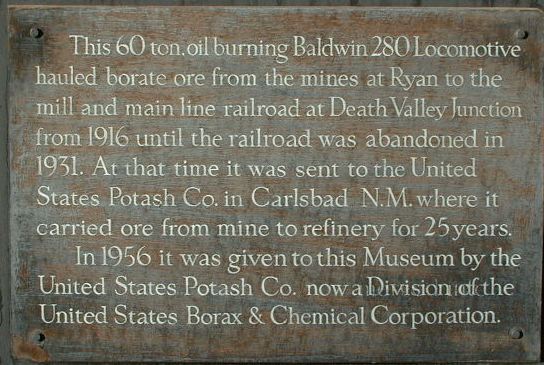 DVRR #2 was the second of two engines of the
Death Valley Narrow-Gauge Railroad which transported borax ore from
the mines at Ryan to the processing plant at Death Valley Junction
between 1916 and 1927, The sixty ton oil-burning locomotive was
sent to the potash mines near Carlsbad, New Mexico in 1931 where it
hauled ore from the mine to the refinery for the next 25 years.
U.S. Potash returned the historic engine to Death Valley in 1956 for
display at the Borax Museum.
DVRR #2 was the second of two engines of the
Death Valley Narrow-Gauge Railroad which transported borax ore from
the mines at Ryan to the processing plant at Death Valley Junction
between 1916 and 1927, The sixty ton oil-burning locomotive was
sent to the potash mines near Carlsbad, New Mexico in 1931 where it
hauled ore from the mine to the refinery for the next 25 years.
U.S. Potash returned the historic engine to Death Valley in 1956 for
display at the Borax Museum.
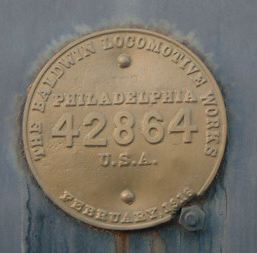 This engine was manufactured by the Baldwin
Locomotive Works of Philadelphia, Pennsylvania in February
1916.
This engine was manufactured by the Baldwin
Locomotive Works of Philadelphia, Pennsylvania in February
1916.
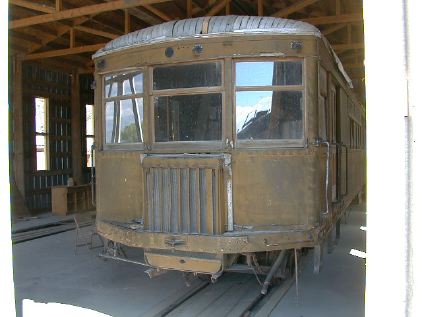 A passenger motor car built by J.G. Brill Company
in November 1928 and numbered 5 was put in service to haul
passengers between Death Valley Junction and New Ryan until the
line was abandoned in December 1931. The locomotives and motor car
were moved the the U.S. Potash Company in Carlsbad, New Mexico
where the car operated until retired in 1956. In 1967, the car was
donated to the Laws Railroad Museum and moved by rail and truck to
Laws, arriving November 27, 1967.
A passenger motor car built by J.G. Brill Company
in November 1928 and numbered 5 was put in service to haul
passengers between Death Valley Junction and New Ryan until the
line was abandoned in December 1931. The locomotives and motor car
were moved the the U.S. Potash Company in Carlsbad, New Mexico
where the car operated until retired in 1956. In 1967, the car was
donated to the Laws Railroad Museum and moved by rail and truck to
Laws, arriving November 27, 1967.
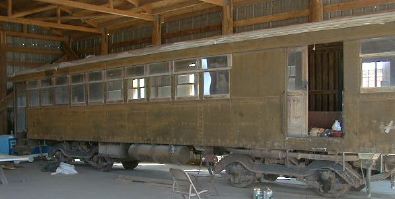 DVRR #5 was use for both passenger and freight
service. The front part of the car is the baggage, driver's and
engine compartment. The rear part contained seats at one time.
DVRR #5 was use for both passenger and freight
service. The front part of the car is the baggage, driver's and
engine compartment. The rear part contained seats at one time.
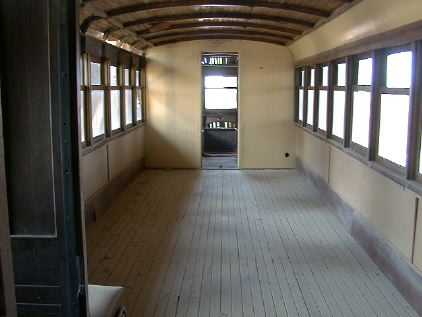 Efforts are underway to restore the car. All
windows were rebuilt and replaced by Mr. Bi Byrne in 1979 and a new
roof and paint job was done by the California Employees Training
Association. Since then the car has been moved from outdoor display
to a newly built carbarn.
Efforts are underway to restore the car. All
windows were rebuilt and replaced by Mr. Bi Byrne in 1979 and a new
roof and paint job was done by the California Employees Training
Association. Since then the car has been moved from outdoor display
to a newly built carbarn.
Due to the rebuilt roof and new windows, the interior of the car is still in fairly good shape however it is clear that the roof needs more work due to degradation over 20 years in the weather. The restorers will have to locate some seats if they make good on their plan to return this car to operational status.
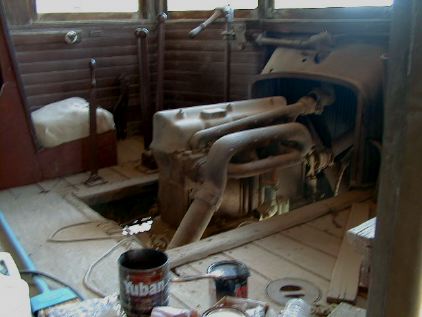 The car is powered by a 4 cylinder gasoline motor
connected to a conventional clutch and manual transmission. The
drive shaft leaves the transmission and goes to a gearhead in the
front truck. Another shaft leaves the rear of the gearhead and
appears to drive an air compressor.
The car is powered by a 4 cylinder gasoline motor
connected to a conventional clutch and manual transmission. The
drive shaft leaves the transmission and goes to a gearhead in the
front truck. Another shaft leaves the rear of the gearhead and
appears to drive an air compressor.
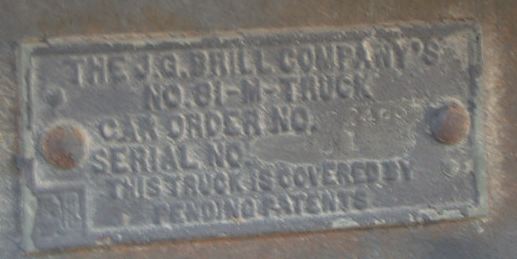 The builder's plate affixed to the
left side of the front truck indicates that the car was
manufactured by Brill.
The builder's plate affixed to the
left side of the front truck indicates that the car was
manufactured by Brill.